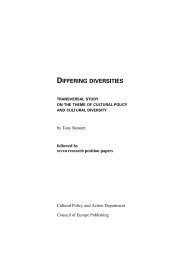Future of Creative Industries - Implications for Research ... - Europa
Future of Creative Industries - Implications for Research ... - Europa
Future of Creative Industries - Implications for Research ... - Europa
Create successful ePaper yourself
Turn your PDF publications into a flip-book with our unique Google optimized e-Paper software.
1. Overview <strong>of</strong> the field1.1. Matters <strong>of</strong> definitionThere is no unique definition <strong>of</strong> these industries. Starting with the very broad name, thenotion may also be referred to as only ‘cultural industries’, ‘creative industries’, ‘futureoriented industries’ in the economic terminology or ‘content industries’ in the technologicalvocabulary. US analysts use increasingly the term <strong>of</strong> ‘entertainment industries’(Hesmondalgh, 2002). However, the terms ‘cultural’ and ‘creative’ industries are the onesmost used in different analyses.The concept <strong>of</strong> ‘cultural industries’ is generally based on a rather functional definition <strong>of</strong>culture than on a broadly anthropological one, culture being seen as “the signifying systemthrough which necessarily (though among other means) a social order is communicated,reproduced, experienced and explored” (Hesmondalgh, 2002, p. 11). From this perspectivethe cultural industries activities have primary aim to generate and communicate symbolicmeanings. Going one step further, analysts such as David Throsby consider a broaderdefinition <strong>of</strong> cultural activities. Seeing them as a different <strong>for</strong>m <strong>of</strong> creativity in theirproduction, the cultural activities concern not only the generation and communication <strong>of</strong>symbolic meanings but additionally their output embodies, at least potentially, some <strong>for</strong>m <strong>of</strong>intellectual property (Throsby, 2001, p. 4). Further developments towards a wider context <strong>of</strong>application led to a shift from the concept <strong>of</strong> cultural industries to the notion <strong>of</strong> creativeindustries, the understanding <strong>of</strong> the creativity concept itself moving from the activities havinga strong artistic component to “any activity producing symbolic products with a heavyreliance on intellectual property and <strong>for</strong> as wide a market as possible” (UNCTAD, 2004,p.4).1.1.1. Cultural industries seen as subset <strong>of</strong> the creative industriesOf great help in understanding the evolution <strong>of</strong> this complex cluster <strong>of</strong> activities is theanalysis made by T. O’Regan on cultural policy, where the author investigates the culturaland creative industries models <strong>of</strong> the last twenty years and points out the gradual progress <strong>of</strong>the terms in the policy context - from the cultural industries to the creative industries, moreprecisely towards considering the cultural industries as a subset <strong>of</strong> the creative industries.(O’Regan, 2001, p. 19-20)O’Regan points out a model used by different states and federal art agencies over the late1980s and 1990s, citing an analysis by David Throsby. There is “a model <strong>of</strong> the culturalindustries centred around the locus <strong>of</strong> origin <strong>of</strong> creative ideas, and radiating outwards as thoseideas become combined with more and more other inputs to produce a wider and wider range<strong>of</strong> products”. The model has a core consisting in the traditional creative arts, surrounded bylayers <strong>of</strong> other industries. The arts core includes: music, dance, theatre, literature, the visualarts, the crafts, as well as newer <strong>for</strong>ms <strong>of</strong> practice such as video art, per<strong>for</strong>mance art,computer and multimedia art (Throsby, 2001, p. 112). The first layer around the core“comprise those industries whose output qualifies as a cultural commodity … but whereother non-cultural goods and services are also produced, such as the proportion <strong>of</strong> … primarycultural goods and services is relatively lower than in the core arts case”. This area includesbook and magazine publishing, television and radio, newspapers and film (p. 113). We couldadd here also elements <strong>of</strong> digital media (e.g. games). Finally, “the boundaries <strong>of</strong> the cultural3














